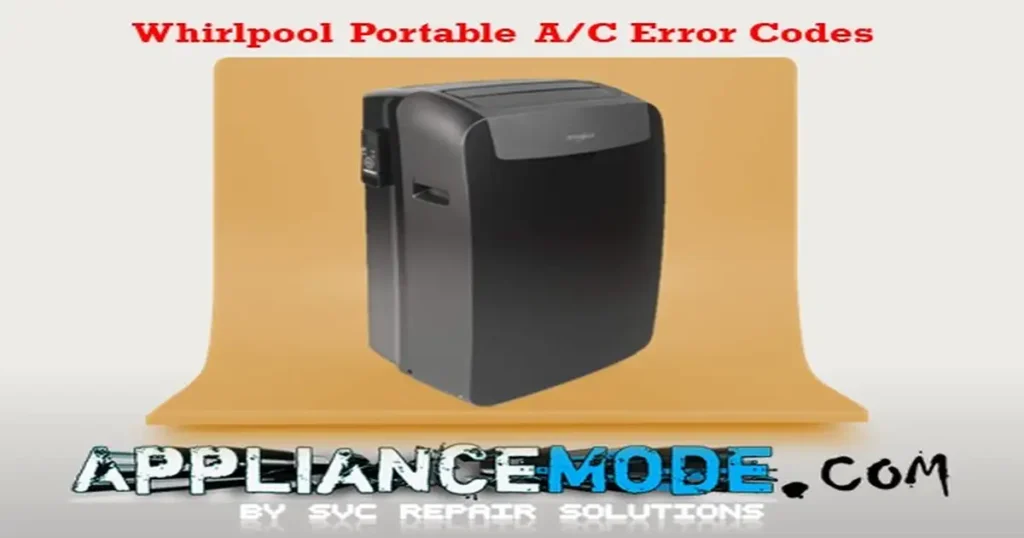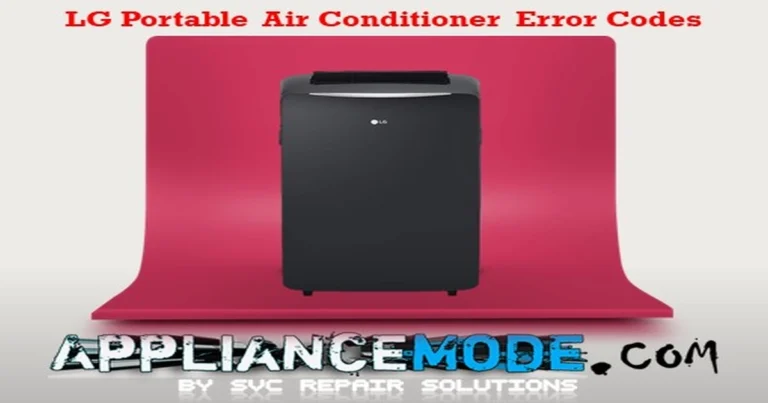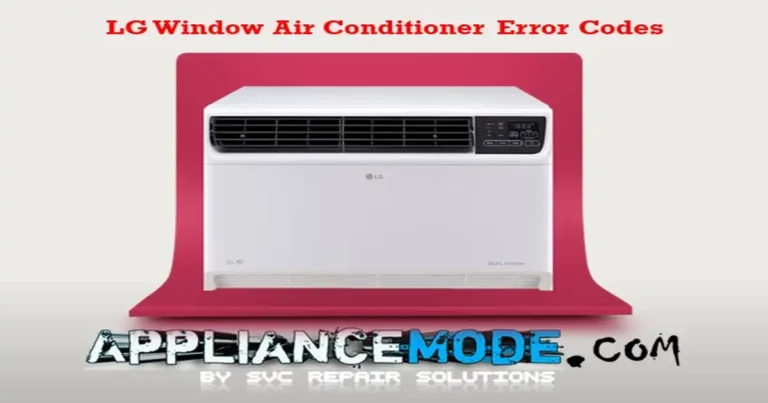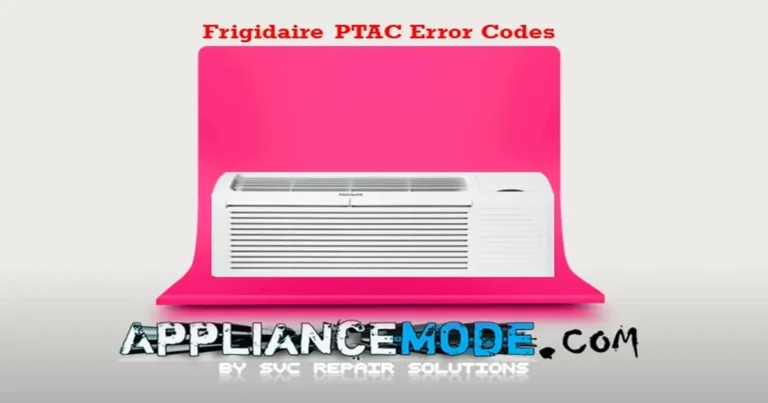Understanding Whirlpool Portable Air Conditioner Error Codes: Your Troubleshooting Guide
This comprehensive guide will demystify the most common error codes you might encounter on your Whirlpool portable air conditioner, empowering you to diagnose and often resolve issues yourself.

Before You Start: Safety First!
Always prioritize safety when troubleshooting your appliance. Before attempting any inspection or repair, always unplug your Whirlpool portable air conditioner from the power outlet. Exercise caution, and if you’re ever unsure, consult a qualified technician.
Whirlpool Portable Air Conditioner Error Codes Explained:
Here’s a breakdown of the common Whirlpool portable air conditioner error codes and what they mean, along with practical troubleshooting steps:
E1: Indoor Ambient Temperature Sensor Error
If your unit displays “E1,” it indicates a problem with the indoor ambient temperature sensor. This sensor is crucial for the air conditioner to accurately read the room temperature and operate efficiently. When it malfunctions, the unit typically shuts down to prevent further issues.
Potential Causes:
- Damaged or broken sensor harness.
- Loose or disconnected sensor.
- An open or short-circuited sensor (meaning it’s not providing a correct reading).
Troubleshooting Steps:
- Inspect the Sensor Harness: Carefully examine the wiring connected to the sensor for any visible damage, kinks, or breaks.
- Verify Sensor Connection: Ensure the sensor is securely plugged into the main control board. A loose connection can often be the culprit.
- Check for Moisture: Look for any signs of moisture around the sensor’s connector. Moisture can interfere with electrical signals.
- Test Sensor Resistance (Advanced): If comfortable, you can use a multimeter to measure the ohmic value (resistance) of the sensor. At approximately 25°C (77°F), a healthy RT sensor should read around 5.4KΩ. If your reading is significantly different, the sensor may be faulty.
E2: Indoor Tube Temperature Sensor Error
Similar to E1, the “E2” error points to an issue with the indoor tube temperature sensor. This sensor monitors the temperature of the refrigerant coils inside the unit, playing a vital role in preventing freezing and ensuring proper cooling.
Potential Causes:
- Damaged or broken sensor harness.
- Loose or disconnected sensor.
- An open or short-circuited sensor.
Troubleshooting Steps:
- Inspect the Sensor Harness: Check the wiring connected to the sensor for any visible damage or breaks.
- Verify Sensor Connection: Confirm the sensor is firmly connected to the main control board.
- Check for Moisture: Look for any moisture around the sensor’s connector.
- Test Sensor Resistance (Advanced): Using a multimeter, measure the ohmic value of the sensor. At approximately 25°C (77°F), an IN-Door Sensor should read around 5.4KΩ. A reading outside this range suggests a potential sensor failure.
E3: Outside Tube Temperature Sensor Error (Heat Pump Models)
This error code, “E3,” is specifically relevant for Whirlpool portable air conditioners that feature a heat pump function. It signifies a malfunction with the outdoor tube temperature sensor, which monitors the refrigerant coils in the outdoor section of the unit (though still self-contained within the portable unit).
Potential Causes:
- Damaged or broken sensor harness.
- Loose or disconnected sensor.
- An open or short-circuited sensor.
Troubleshooting Steps:
- Inspect the Sensor Harness: Examine the wiring connected to the sensor for any damage.
- Verify Sensor Connection: Ensure the sensor is securely plugged into the main control board.
- Check for Moisture: Look for any moisture around the sensor’s connector.
- Test Sensor Resistance (Advanced): Measure the ohmic value of the sensor with a multimeter. At approximately 25°C (77°F), an outdoor sensor should read around 5.4KΩ.
E5: Full Water Tank Notification
The “E5” error is a common and often easily resolved issue. It indicates that the internal water tank, which collects condensation, is full, or that the float switch designed to detect this is not functioning correctly. To prevent overflow, the unit will stop operating.
Potential Causes:
- The water tank is indeed full of condensed water.
- The float switch, which signals a full tank, is stuck or malfunctioning.
Troubleshooting Steps:
- Empty the Water Tank: Manually drain the water tank. Most portable ACs have a drain plug or hose for this purpose.
- Test the Float Switch Circuit: If the tank is empty but “E5” persists, the float switch may be the problem. Gently shake the unit a bit to see if the float switch resets.
- Inspect Wiring: Check the wiring connecting the main control board to the float switch for any breaks or disconnections.
- Examine the Float: Look at the float mechanism within the water tank for any physical obstructions or damage that might prevent it from moving freely.
E6: Upper Motor Malfunction & E7: Lower Motor Malfunction
These two error codes, “E6” and “E7,” indicate issues with the fan motors in your unit. “E6” points to a problem with the upper motor, while “E7” signals a malfunction with the lower motor. When either of these motors fails to provide proper feedback, the air conditioner will shut down as a protective measure.
Potential Causes:
- The fan motor is physically jammed by an obstruction.
- A defective fan motor itself.
- A faulty main control board that isn’t supplying power or receiving feedback from the motor.
Troubleshooting Steps:
- Check for Obstructions: Unplug the unit and carefully attempt to turn the fan blades by hand. Look for any debris, wires, or other obstructions that could be preventing the fan from rotating freely. Remove any obstructions found.
- Test the Fan Circuit (Advanced): If comfortable with electrical testing, you can check for voltage at the fan motor.
- Replace Fan Motor: If there is voltage supplied to the fan motor but it still doesn’t turn, the fan motor itself is likely defective and needs replacement.
- Replace Main Board: If there is no voltage reaching the fan motor, the issue likely lies with the main control board, and it may need to be replaced.
EA: Communication Failure
The “EA” error code signifies a communication breakdown between the main control board and the user interface (UI) board. Essentially, these two critical components are not “talking” to each other correctly.
Potential Causes:
- Incorrect supply voltage to the unit.
- A wiring problem between the main board and the UI board (loose, damaged, or disconnected).
- A defective main board or UI board.
Troubleshooting Steps:
- Verify Supply Voltage: Ensure your unit is receiving the correct voltage from the power outlet, matching the rated voltage specified in your owner’s manual. An inconsistent power supply can cause communication issues.
- Inspect Wiring Harness: Unplug the unit and carefully inspect the wiring harness connecting the main board and the UI board. Look for any signs of damage, cuts, or loose connections.
- Reseat Connectors: Disconnect and then firmly reconnect the wiring harness connectors on both the main board and the UI board. Sometimes, simply reseating a connection can resolve the issue.
- Replace Components (If Issues Persist): If the problem persists after checking voltage and wiring, it’s possible that either the main board or the UI board is defective and may need to be replaced. This often requires professional assistance.
Conclusion: Empowering Your AC Troubleshooting
Understanding the common error codes associated with your Whirlpool portable air conditioner can be a real game-changer. By knowing what each code signifies and following these troubleshooting steps, you’ll be better equipped to diagnose and often resolve minor issues yourself. This can save you time, money, and the frustration of a malfunctioning unit, keeping your space cool and comfortable.

I am a master Appliance Repair technician with over 35 years of experience in the field. I am passionate about helping people troubleshoot their appliances and fix common problems. My website, appliancemode.com, provides a wealth of information on troubleshooting common appliance issues and deciphering error codes. This website aims to empower people to tackle appliance repairs themselves and save money on service calls.



